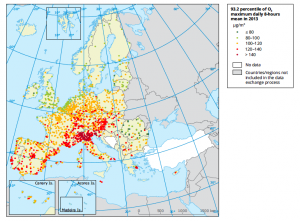Ozone is a highly reactive oxidant which, when inhaled, can worsen bronchitis and emphysema, trigger asthma, and permanently damage lung tissue. Studies have shown that short-term exposure to peak levels of ozone can temporarily affect the lungs, the respiratory tract, and the eyes and can also increase susceptibility to inhaled allergens. Long-term exposure to ozone has primarily been found to reduce lung function. Children, the elderly and people with lung or cardiovascular disease are particularly at risk of adverse health effects.
According to the report “Air Quality in Europe” the estimated impact of exposure to O3 concentrations in 2011 on the European population was about 17400 premature deaths per year, as a total for the 40 countries, and about 16160 in the EU-28, originating from short-term exposure.
In addition, O3 is considered to be the most damaging air pollutant to vegetation and crops. Ozone reduces the ability of plants to absorb CO2, altering their growth and variety. It damages ecosystem structures and functions, as well as the health and productivity of crops, thus threatening food security.
In 2011, about 18% of the agricultural area in the 33 member states of the European Environment Agency was exposed to O3 levels above the target value for protecting crops, with the highest impacts being felt in Italy and Spain. The long-term objective was exceeded in 87% of the agricultural area. In addition, the critical level for the protection of forests was exceeded in 67% of the total forest areas in the 33 member states.

Taken from the Air Quality in Europe – 2015 report

